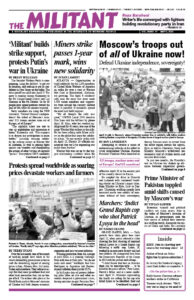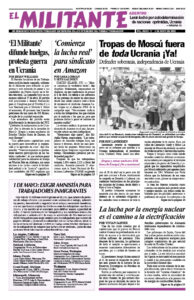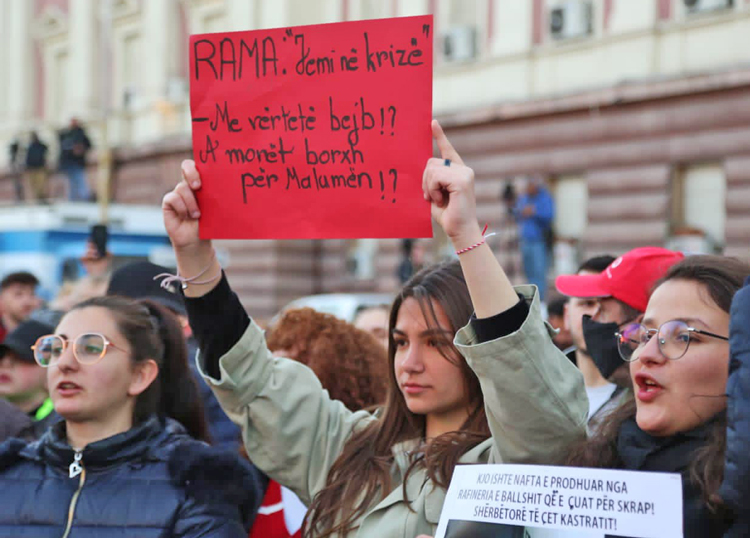Over the last month, tens of thousands of working people have taken to the streets demanding government action to curb the devastating impact of soaring prices in Iran, Albania, Peru, Sri Lanka, Sudan and elsewhere. They refuse to accept that they must go without food and other basic necessities they can no longer afford. The actions take place as the World Bank predicts Moscow’s invasion of Ukraine will both deepen economic stagnation and spur yet more inflation.
Winning protection from the scourge of price hikes is a growing challenge. Even with two or three jobs, “we do not make ends meet,” bricklayer José Luis Rodríguez in Argentina told Reuters. Annual inflation there just hit 55.1%.
In Sri Lanka days of protests following price hikes on rice and other essentials deepened a government crisis, forcing ministers to quit. Peruvian President Pedro Castillo had to rapidly reverse a curfew his government imposed April 5 after the measure was widely ignored by demonstrators demanding relief from the rising cost of food, fuel and fertilizer.
As the impact of this worldwide crisis continues to reverberate, the International Monetary Fund is holding talks with governments in Egypt, Sri Lanka and Tunisia on “restructuring” their staggering debts. This is to ensure that payments to the wealthy bondholders are made, putting the devastating consequences on the backs of the toiling majority. “Developing-country debt has risen sharply to a 50-year high,” David Malpass, president of the World Bank Group, noted last week.
In the U.S. annual inflation reached 8.5% last month, while average wages only rose 5.6% — the biggest drop in real wages for 40 years. Gasoline prices were up 48% over the year, while meat, poultry, fish and eggs rose by 13.7%.
In the face of this squeeze, strike struggles for wage hikes by miners at Warrior Met Coal in Alabama, nurses at Sutter Health facilities in Northern California and unionists elsewhere deserve widespread support and set an important example to millions.
“We need to spread the word about each of these fights and build solidarity from working people and our unions,” Osborne Hart, Socialist Workers Party candidate for U.S. Senate from Pennsylvania, told the Militant. “Workers can’t stop inflation, but we can turn to our unions and use them to fight for protection from its effect. We need to fight for wage raises and automatic cost-of-living adjustments in all contracts. And to extend these protections to all benefits and pensions, as well as government programs like Social Security, so whenever prices rise, our wages go up.”
President Joseph Biden blames Moscow’s invasion of Ukraine for 70% of recent inflation. Kristalina Georgieva, head of the IMF, echoed his views, calling the war “a massive setback” to “our collective prosperity.” For millions of working people there has been no prosperity, “collective” or otherwise.
Price raises were wreaking havoc on working-class livelihoods long before Putin’s invasion, but the war tightened the squeeze. Russia and Ukraine export one-quarter of the world’s wheat, but since the war began much of it isn’t getting moved. As a result the price of bread has risen 70% in Lebanon from the start of March. David Beasley, executive director of the U.N.’s World Food Program, says millions more people worldwide now face starvation, as the agency has halved its shipments of grain.
All of this worsened but didn’t trigger current inflation. Price hikes result from capitalist governments printing huge sums of money, lowering their currencies’ purchasing power, in response to rising debt levels. This follows sharpening competition for markets after decades of stagnating profit rates. Wars and military buildup — which cost billions but produce nothing of value — spur inflationary pressures.
Both the current Democratic administration and its Republican predecessor printed $5 trillion as part of “stimulus” packages during the pandemic. Both expanded the U.S. military murder machine. A similar course was carried out by other capitalist governments, resulting in more cash being available for fewer goods, pushing up prices.
The cost of a house mortgage in the U.S. has surged by more that a third over the past year. Mortgage interest rates hit 5% for the first time since 2011. House repossessions are now rising sharply, with foreclosures going up sevenfold in January over the previous month. And the cost of renting a place to live in the 50 largest metropolitan areas of the U.S. soared by 19.3% over the last year.
These conditions add special obstacles to young workers wishing to start a family. Nearly 18% of the U.S. population now is crammed into multigenerational households, four times as many as in 1971. More and more are unable to afford a place of their own, distorting the choices working people — women and men — make about how to live their lives and the options women face about when and whether to give birth.
Higher wages don’t cause inflation
Bosses and press commentators turn the causes of this crisis on its head. Typical was an April 12 article by New York Times columnist Paul Krugman. “The U.S. economy still looks overheated,” he complained. “Rising wages are a good thing, but right now they’re rising at an unsustainable pace.”
Under capitalism employers grab for themselves as large a portion of the wealth our labor produces as they can, pushing to hold down wages and intensifying our exploitation through speedup and longer hours. When we win higher wages it doesn’t result in price hikes, but cuts into the profits the exploiting class appropriates from us.
Krugman then offers his “solution” to inflation, saying, “We need to see unemployment tick up at least a bit.” The capitalists and upper-middle-class layers that he writes for vociferously denounce workers fighting for better wages.
The boss press crows about low unemployment today. But that isn’t the real story. In fact, more of us are out of work than two years ago. The labor force participation rate — a measure of the number of workers employed or actively looking for work — remains far lower than before the pandemic. People have either given up looking, or have to succumb to pressure to stay home, from the lack of affordable child care or elderly care.
“The workforce dropouts tend to be women, lack a degree and have worked in low-paying fields,” the Wall Street Journal reported April 16.


